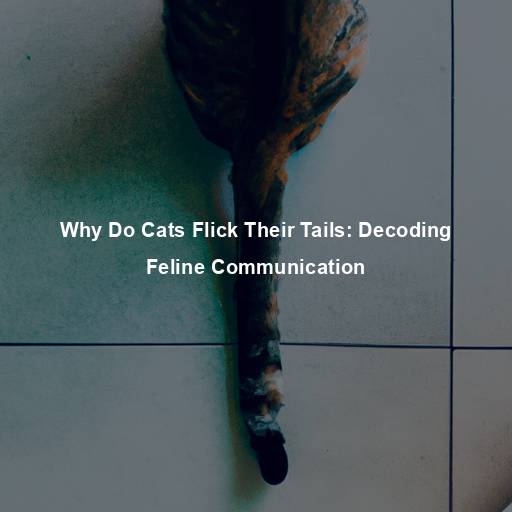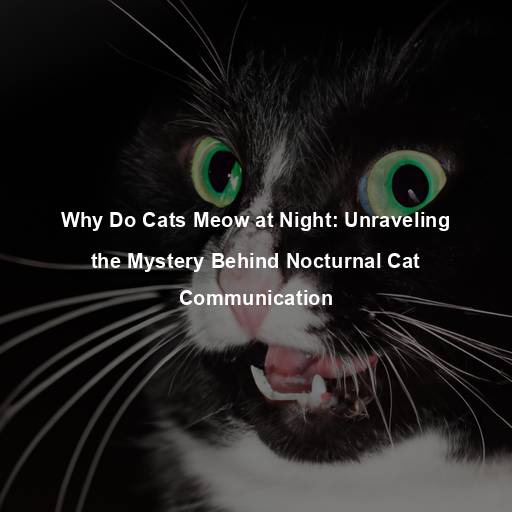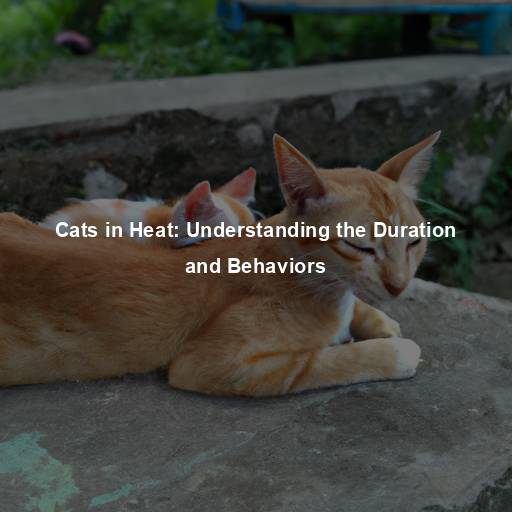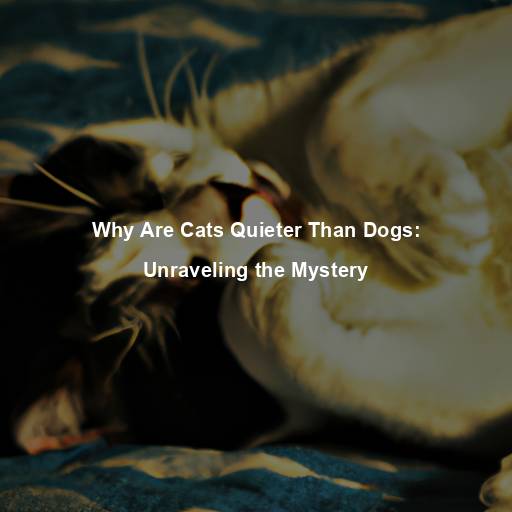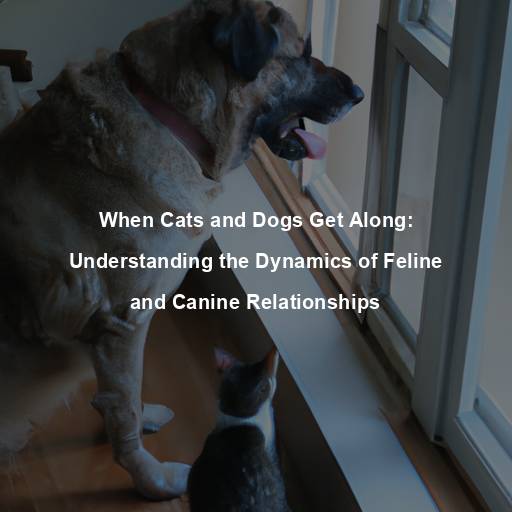Why Do Cats Flick Their Tails: Decoding Feline Communication
Last Updated on October 22, 2023 by Evan
Contents
- 1 The Intricate Language of Feline Tails
- 1.1 Understanding Feline Body Language
- 1.2 Tail Flicking as a Sign of Agitation or Annoyance
- 1.3 Tail Flicking as a Sign of Excitement or Anticipation
- 1.4 Tail Flicking as a Sign of Fear or Anxiety
- 1.5 Tail Flicking as a Sign of Curiosity or Interest
- 1.6 Tail Flicking as a Sign of Contentment or Relaxation
- 1.7 Tail Flicking as a Sign of Communication with Other Cats
- 1.8 Tail Flicking and Health Concerns
- 1.9 Decoding the Feline Tail Flick: A Language of its Own
- 1.10 The Tail as an Extension of Emotion
- 1.11 The Elegance of Tail Postures
- 1.12 Tail Communication: Beyond Flicks and Postures
- 1.13 The Tail as a Window to the Feline Soul
- 2 FAQs: Why Do Cats Flick Their Tails?
The Intricate Language of Feline Tails
Cats are fascinating creatures that possess a unique way of communicating with their human companions and fellow felines. One of the most intriguing behaviors exhibited by cats is the flicking of their tails. This seemingly simple action holds a wealth of information about a cat’s emotional state, intentions, and overall well-being. In this article, we will delve into the world of feline communication and explore the various reasons why cats flick their tails.
Understanding Feline Body Language
In order to decipher the meaning behind a cat’s tail flicks, it is essential to grasp the fundamentals of feline body language. Cats use their entire bodies to convey messages, and their tails serve as a prominent tool for communication. Each movement and position of their tails carries a specific message, signaling a range of emotions and intentions.
Tail Flicking as a Sign of Agitation or Annoyance
One common reason for cats to flick their tails is to express agitation or annoyance. When a cat’s tail starts to twitch or flick rapidly from side to side, it often indicates that the cat is experiencing some form of irritation. This could be triggered by various factors, such as an unwanted interaction, loud noises, or a change in their environment. It is crucial to respect a cat’s boundaries when they display this behavior, as further provocation may lead to aggression.
Tail Flicking as a Sign of Excitement or Anticipation
In the intriguing world of cats, their tails hold many enigmatic tales. It’s fascinating to observe how these furry beings express themselves, as the act of tail flicking can be delightfully perplexing. While it can indicate agitation, it also has the potential to unveil excitement and anticipation. Understanding the cryptic language of cats involves diving into the intricacies of their body language, such as the sway and playful flicks of their tails, accompanied by dilated pupils, a gracefully arched back, and an overall alert demeanor.
Tail Flicking as a Sign of Fear or Anxiety
Another reason why cats flick their tails is to convey fear or anxiety. When a cat feels threatened or fearful, their tail may puff up and flick rapidly. This defensive display is an attempt to make themselves appear larger and more intimidating to potential threats. It is essential to create a safe and secure environment for a cat exhibiting this behavior, as prolonged fear and anxiety can have detrimental effects on their overall well-being.
Tail Flicking as a Sign of Curiosity or Interest
The feline fascination with the unknown is undeniable, as their tails serve as enigmatic extensions of their curiosity. A captivating dance unfolds when a cat is captivated, with their tails reverently twitching and flicking in a delicate symphony. Alongside a piercing gaze and an undeniably engrossed stance, their tails become vessels of exploration, transmitting signals of intrigue and an insatiable thirst for discovery.
Tail Flicking as a Sign of Contentment or Relaxation
It’s time to debunk the cat tail flicking myth! Surprisingly, these feline gestures aren’t always an indicator of negative emotions. In fact, cats can exhibit tail flicks to convey contentment or relaxation in certain situations. Picture this: a blissful cat, swaying its tail gracefully from side to side, basking in peaceful rest or enjoying a gentle stroke from their beloved human.
Tail Flicking as a Sign of Communication with Other Cats
Did you know that cats have more tricks up their paws than just meowing? It turns out their tails also play a pivotal role in their mysterious feline language. Whether it’s a quick flick or a slow swish, these tail movements are like secret signals between our furry friends, letting them communicate without saying a word. From establishing social hierarchies to engaging in playful banter, the way cats use their tails is truly a marvel of nature’s enigmatic design.
Tail Flicking and Health Concerns
While tail flicking is predominantly a normal behavior, it is essential to be aware of any sudden or excessive tail flicking that may indicate underlying health concerns. Cats may flick their tails excessively due to discomfort or pain caused by injury, urinary tract issues, or other medical conditions. If accompanied by other concerning symptoms, such as changes in appetite, lethargy, or vocalization, it is crucial to seek veterinary attention promptly.
Decoding the Feline Tail Flick: A Language of its Own
When it comes to the flicking of a cat’s tail, there’s more than meets the eye. Far from being a random motion, this seemingly simple movement holds a myriad of meanings and messages. Whether it’s a twitch, a wag, or a graceful sway, feline tails are a captivating form of communication that both humans and fellow cats can tune into. By delving into the mysterious world of tail flicking, we can unravel the intricacies of our furry companions and foster a deeper connection with them.
The Tail as an Extension of Emotion
Cats possess an innate ability to communicate through subtle gestures, and their tails play a significant role in this intricate dance of feline communication. Just like humans use their facial expressions and body language to convey emotions, cats utilize their tails as an extension of their feelings. Each flick, twitch, or wag of their tail carries a distinct message, offering insights into their state of mind. Let’s delve deeper into the captivating world of feline tail language.
The Elegance of Tail Postures
Cats, those enigmatic creatures, possess a hidden language spoken through the flicker and sway of their majestic tails. It’s through this intricate dance of tail positions that they divulge their innermost emotions and secret agendas. So, dear reader, let us embark on a journey of deciphering the cryptic codes encoded within the seemingly mundane movements of our beloved feline companions. Prepare to be enlightened and bewildered by the fascinating array of tail postures and their mystifying interpretations.
Erect Tail: Confidence and Happiness
There is something truly captivating about the regal posture of a cat with its tail held high – a surefire symbol of confidence and contentment. This upright tail serves as a telltale sign of a feline companion’s emotional bliss and relaxation, making a statement about their overall state of happiness and contentedness in their surroundings. It’s almost as if they’re proudly proclaiming their well-being and utter satisfaction with the world around them.
Low-Hanging Tail: Fear and Submission
At the opposite side of the spectrum, a tail that hangs low or snuggles between a cat’s hind legs depicts a profound sense of fear or submission. It is an unmistakable signal of unease or distress when a feline adopts this protective stance, hinting towards discomfort or anxiety. This defensive posture is often an instinctive response to feeling threatened or overwhelmed within its surroundings.
Puffed-Up Tail: Aggression or Fear
When a cat’s tail puffs up like a bottlebrush, it is a powerful display of aggression or fear. This defensive posture makes the cat appear larger and more intimidating, serving as a warning to potential threats. It is crucial to approach a cat with a puffed-up tail cautiously, as it may be on the verge of aggression.
Wrapped Tail: Relaxation and Trust
When a cat lovingly cocoons itself with its tail, it’s like unlocking the gateway to relaxation and trust. This endearing gesture is commonly witnessed when our feline friends find the purrfect little nook and cranny to nestle into, surrounded by an air of safety and contentment. It’s a visual declaration that the elusive feline is in a state of tranquility, ready to embrace tender moments of connection.
Wagging Tail: Mixed Emotions
When it comes to tail wagging, cats are a whole different ball game compared to dogs. Unlike their canine counterparts, cats have a more enigmatic approach to tail movements. They sway their tails in a manner that’s both delicate and deliberate, leaving us humans perplexed. This ambiguous gesture could signal a range of emotions, from curiosity to uncertainty or even a touch of annoyance.
Tail Communication: Beyond Flicks and Postures
Tail flicking and tail postures are not the only ways cats communicate through their tails. The direction of a cat’s tail movement, along with other accompanying cues, provides further insights into their intentions and emotions.
Tail Pointing Upwards: Friendly Greeting
Ever wondered what it means when a feline gracefully saunters over with its tail held high? Brace yourself for some whiskery wisdom – this elegant gesture is their way of extending a furry, friendly hello! Whether it’s two cuddly companions reconnecting or your own fluffy sidekick showering you with love, this enchanting display speaks volumes about their penchant for positivity and harmonious encounters. So next time a regal cat waltzes your way, embrace the heartwarming warmth of their tail-waving salutation.
Tail Lashing: Warning or Agitation
A tail lashing back and forth is a clear indication of warning or agitation. This rapid movement suggests that the cat is feeling threatened or annoyed and is ready to defend itself if necessary. It is crucial to give the cat space and avoid provoking it further in such situations.
Tail Quivering: Excitement or Anticipation
In the mysterious realm of feline behavior, a fascinating phenomenon emerges – the quivering tail. Akin to a delicate dance, it unravels amidst moments of fervent anticipation and pulsating eagerness. Whether waltzing in anticipation of a sumptuous feast or pirouetting in the anticipation of play, the quivering tail becomes a visual symphony that magnifies a cat’s electrifying emotions.
Slow Tail Blinking: Trust and Affection
In the realm of feline communication, there exists a secret language beyond the realm of mere physicality—a language where tails take on a life of their own. Amidst the intricate tapestry of gestures, there lies a particularly enigmatic phenomenon known as the slow tail blink. This subtle act, accompanied by a gentle sway of the tail, becomes a cryptic code of trust and adoration. Often witnessed between feline kindred spirits or when a cat desires to convey its profound affection and solace to its human counterpart, this behavior exudes a perplexing charm that transcends the boundaries of comprehension.
The Tail as a Window to the Feline Soul
Within the enigmatic world of feline communication lies a secret code waiting to be unraveled – the language spoken by their eloquent tails. These seemingly mundane flicks, postures, and movements hold a hidden wealth of meaning, a captivating tapestry of signals that allow us a window into the feline soul. As we delve deeper into their intricate dance, we unlock not only a greater understanding of our beloved companions but also a closer and more profound connection with them. So, let us embark on this bewitching journey, embracing the perplexity and bursting forth into a world where every wag of a tail reveals a piece of the captivating language of cats.
FAQs: Why Do Cats Flick Their Tails?
What does it mean when cats flick their tails?
Have you ever wondered what goes on in a cat’s mind when they flick or swish their tails? Well, let me unravel the perplexing world of feline communication for you. You see, these tail flicks are not just random movements; they are bursting with hidden messages. Each flick holds the key to unlocking the cat’s current emotional state. It’s like they have their own secret language, expressing anything from excitement and playfulness to annoyance, fear, or even agitation. So, next time you spot a tail flick, remember to decode the context and other body language to truly grasp what your furry friend is trying to convey.
Why do cats flick their tails when they are angry?
When a cat is angry or annoyed, it may aggressively flick its tail back and forth in a rapid and forceful manner. This tail movement is often accompanied by other signs of aggression such as flattened ears, dilated pupils, hissing, or growling. The intense tail flicking serves as a warning sign, indicating that the cat is feeling threatened or ready to defend itself if necessary. It is important to respect your cat’s boundaries and avoid any further provocation when you observe this behavior.
Do cats flick their tails when they are happy?
Yes, cats can also flick their tails when they are happy or excited. However, the tail motion in these situations tends to be more gentle and relaxed compared to an angry or agitated flicking. A joyful tail flick is often seen during playtime or when the cat is eagerly anticipating something, like a meal or affection from their owner. It is a positive expression of their emotions and can be associated with an overall content and relaxed state.
Are there any other reasons why cats flick their tails?
Cats, these enigmatic creatures, possess a secret language that extends far beyond their enchanting purrs and graceful stares. It seems that their tails, oh so agile and expressive, hold the key to unlocking their silent dialogues with both fellow animals and the perplexing human species. A flick here, a flick there – these seemingly ordinary gestures are like cryptic signals, whispering tales of curiosity, intrigue, and the desperate desire to grab attention. But the mystery deepens, for when engaging in their feline hunt, cats transform their tails into cunning weapons, mimicking the mesmerizing movements of their elusive prey, captivating attention and focusing their predatory instincts. And yet, amidst the plot twists of their intricate communication, a twist of fate awaits, as anxiety and stress gnaw at their delicate souls, causing their tails to twitch uncontrollably, revealing a visual enigma that warns of their internal turmoil.
Can tail flicking be a sign of illness in cats?
When it comes to our feline friends, deciphering their mysterious body language can be as perplexing as solving a Rubik’s cube blindfolded. One particular puzzler that should raise our eyebrows is excessive or peculiar tail flicking. Could it be a harmless kitty quirk or a telltale sign that something is amiss in their health department? Keep your detective hat on and don’t miss other behavioral red flags like changes in appetite or litter box habits. If your cat’s tail flicking extravaganza comes hand in hand with concerning symptoms, don’t hesitate to consult a veterinarian. A professional evaluation will help unravel the enigma and determine if further medical attention is required.
We must always keep in mind that each and every cat possesses its own special qualities that make it unlike any other. The subtle art of tail flicking, though seemingly uniform, may carry various messages depending on the feline in question. By taking the time to observe our cats’ intricate forms of nonverbal communication, as well as considering the broader context in which these graceful flicks occur, we can unlock the enigmatic mysteries of their individual needs and desires.

